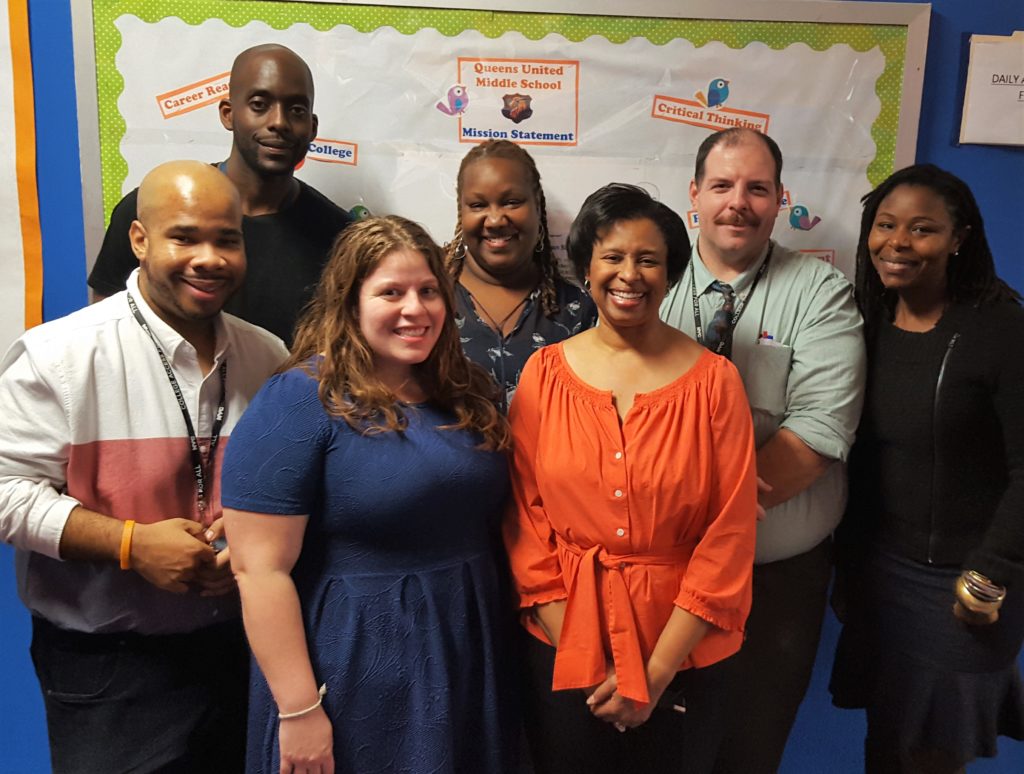Cool Down the Hot Spots: Tools for Transition

Left to Right: Matthew Ogle, dean; Devon Ray, PE Teacher; Christina Ayala, seventh-grade science teacher; Adrienne Haskell, social work consultant; Sharon Chapman, instructional coach; Nicholas Panteleo, eighth-grade math teacher; and Kara Stevens, assistant principal.
Turnaround for Children’s school-based teams work intensively with educators to build integrated systems, strategies and skills that are sustainable beyond the formal partnership. Seeing a group of teachers take what they’ve learned from partnering with Turnaround and make it their own is an important goal. Instructional Coach Sharon Chapman shares an example of one successful sustainability practice established at Queens United Middle School.
In the first weeks of its partnership with Queens United Middle School, the Turnaround team deployed its Schoolwide Evaluation and Assessment Tool (SEAT) to surface areas of focus and improvement for the school partnership. Through classroom observations, interviews with school leaders, teachers and students and observation of “hot spots,” meaning the hallways, the cafeteria, stairwells, etc., SEAT captures whether critical systems and processes are in place.
One of the things that SEAT revealed, explained Instructional Coach Sharon Chapman, was the lack of established transition procedures. “Basically, there wasn’t a plan for how students moved from one class to another. For example, in some schools, you might see students walk on the right side of a hallway. But at Queens United, when the bell rang, everyone did their own thing. There weren’t any expectations or standards around how students and adults should behave.”
The Turnaround team made transitions a priority with the aim creating a safer school environment for everyone. Improving transitions, they believed, would reduce chaos in common areas and lateness to class, cut down disciplinary actions, such as demerits or suspensions, and maximize instructional time.
Chapman worked with Principal Richard Roder to recruit a team of teachers to address the issue because they know the school best and can recommend strategies tailored to its specific environment. Among the team members were Cristina Ayala, a seventh-grade science teacher, Matthew Ogle, dean, Nicholas Pantaleo, an eighth-grade math teacher, Devon Ray, the school’s physical education teacher and Kara Stevens, assistant principal. The goal: design a proactive plan to improve hallway and stairway transitions, instead of constantly reacting to issues.
What started as a Turnaround initiative, quickly became something the teachers themselves owned. The Turnaround team of Adrienne Haskell, Jahkia Sanders, Tom Gambardella and Chapman shifted from leaders to facilitators and finally thought partners.
“It was amazing to watch the teacher leaders take ownership over this work,” said Sharon. “When they realized they needed student and colleague input, they came to us. They came up with the questions, conducted the interviews and analyzed the data themselves.”
Each teacher leader paired up with a Turnaround staff member and met with their grade level colleagues to share their thinking and gather feedback. The transition team also met monthly during the school year, for a full day in June and again in late August to develop norms and a procedure specific to each grade.
The team followed a strategy called ESPMR. They worked with teachers to explain the reason for needing a transition plan, specify student behaviors for smooth transitions, practice these behaviors, monitor students using the strategy and then review the strategy.
Before the first day of school, the transition team trained all staff at Queens United. They established clear guidelines for where classes would line up and how students would walk in the halls. They then practiced how transitions would look before students arrived. As a result of all this hard work, the first day of the 2017-18 school year was the best opening Queens United has ever seen. Transitions were seamless and hallways were calm and quiet.
Hallway transitions may seem like a minor thing to spend so much time on, but they set the tone for the whole school. Students are less likely to be triggered because the procedures they have learned help them remain calm moving from one classroom to another. This means teachers are spending less time helping students to settle down at the start of a period and more time on teaching. Queen United Middle School is on the road to fostering a safe, supportive learning environment.

Share This Story